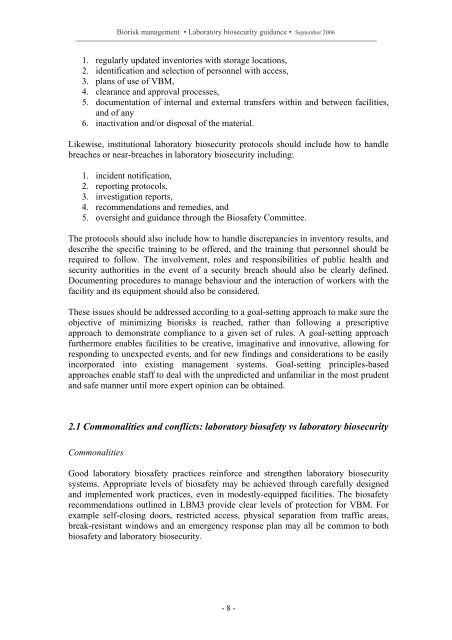Laboratory biosecurity guidance - World Health Organization
Laboratory biosecurity guidance - World Health Organization
Laboratory biosecurity guidance - World Health Organization
Create successful ePaper yourself
Turn your PDF publications into a flip-book with our unique Google optimized e-Paper software.
Biorisk management • <strong>Laboratory</strong> <strong>biosecurity</strong> <strong>guidance</strong> • September 2006<br />
1. regularly updated inventories with storage locations,<br />
2. identification and selection of personnel with access,<br />
3. plans of use of VBM,<br />
4. clearance and approval processes,<br />
5. documentation of internal and external transfers within and between facilities,<br />
and of any<br />
6. inactivation and/or disposal of the material.<br />
Likewise, institutional laboratory <strong>biosecurity</strong> protocols should include how to handle<br />
breaches or near-breaches in laboratory <strong>biosecurity</strong> including:<br />
1. incident notification,<br />
2. reporting protocols,<br />
3. investigation reports,<br />
4. recommendations and remedies, and<br />
5. oversight and <strong>guidance</strong> through the Biosafety Committee.<br />
The protocols should also include how to handle discrepancies in inventory results, and<br />
describe the specific training to be offered, and the training that personnel should be<br />
required to follow. The involvement, roles and responsibilities of public health and<br />
security authorities in the event of a security breach should also be clearly defined.<br />
Documenting procedures to manage behaviour and the interaction of workers with the<br />
facility and its equipment should also be considered.<br />
These issues should be addressed according to a goal-setting approach to make sure the<br />
objective of minimizing biorisks is reached, rather than following a prescriptive<br />
approach to demonstrate compliance to a given set of rules. A goal-setting approach<br />
furthermore enables facilities to be creative, imaginative and innovative, allowing for<br />
responding to unexpected events, and for new findings and considerations to be easily<br />
incorporated into existing management systems. Goal-setting principles-based<br />
approaches enable staff to deal with the unpredicted and unfamiliar in the most prudent<br />
and safe manner until more expert opinion can be obtained.<br />
2.1 Commonalities and conflicts: laboratory biosafety vs laboratory <strong>biosecurity</strong><br />
Commonalities<br />
Good laboratory biosafety practices reinforce and strengthen laboratory <strong>biosecurity</strong><br />
systems. Appropriate levels of biosafety may be achieved through carefully designed<br />
and implemented work practices, even in modestly-equipped facilities. The biosafety<br />
recommendations outlined in LBM3 provide clear levels of protection for VBM. For<br />
example self-closing doors, restricted access, physical separation from traffic areas,<br />
break-resistant windows and an emergency response plan may all be common to both<br />
biosafety and laboratory <strong>biosecurity</strong>.<br />
- 8 -

















